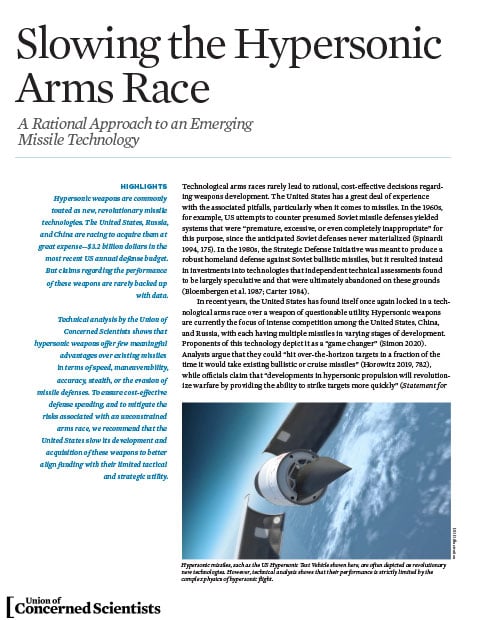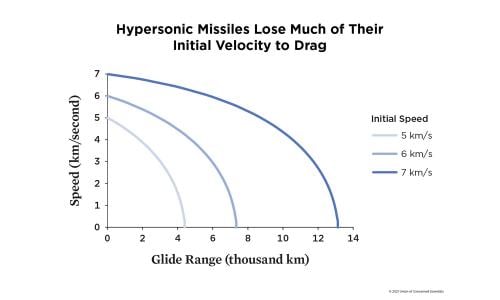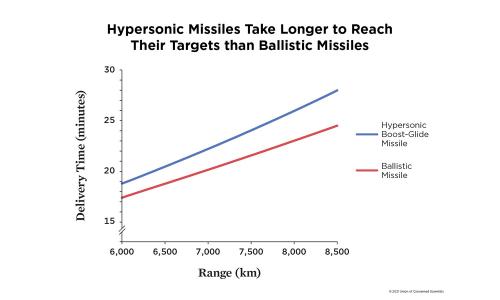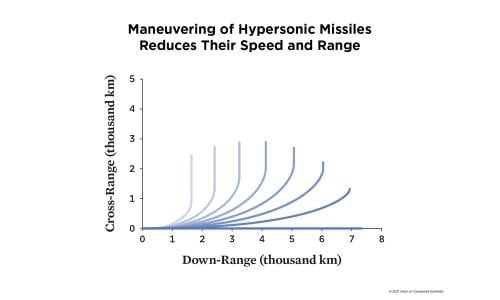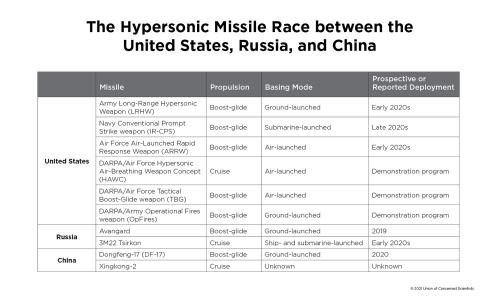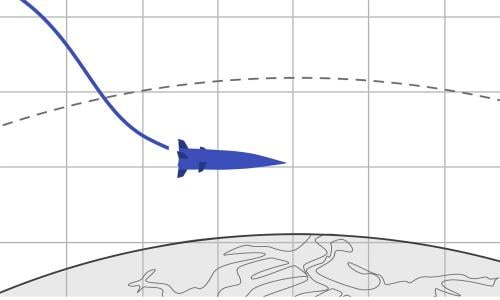Hypersonic weapons are commonly touted as new, revolutionary missile technologies. The United States, Russia, and China are racing to acquire them at great expense—$3.2 billion dollars in the most recent US annual defense budget.
But claims regarding the performance of these weapons are rarely backed up with data. Technical analysis by the Union of Concerned Scientists shows that hypersonic weapons offer few meaningful advantages over existing missiles in terms of speed, maneuverability, accuracy, stealth, or the evasion of missile defenses. To ensure cost-effective defense spending, and to mitigate the risks associated with an unconstrained arms race, we recommend that the United States slow its development and acquisition of these weapons to better align funding with their limited tactical and strategic utility.
Slowing the Hypersonic Arms Race
This is a condensed, online version of the report. Access to all figures and full report are available through download of the PDF.
Technological arms races rarely lead to rational, cost-effective decisions regarding weapons development. The United States has a great deal of experience with the associated pitfalls, particularly when it comes to missiles. In the 1960s, for example, US attempts to counter presumed Soviet missile defenses yielded systems that were “premature, excessive, or even completely inappropriate” for this purpose, since the anticipated Soviet defenses never materialized (Spinardi 1994, 175). In the 1980s, the Strategic Defense Initiative was meant to produce a robust homeland defense against Soviet ballistic missiles, but it resulted instead in investments into technologies that independent technical assessments found to be largely speculative and that were ultimately abandoned on these grounds (Bloembergen et al. 1987; Carter 1984).
In recent years, the United States has found itself once again locked in a technological arms race over a weapon of questionable utility. Hypersonic weapons are currently the focus of intense competition among the United States, China, and Russia, with each having multiple missiles in varying stages of development. Proponents of this technology depict it as a “game changer” (Simon 2020). Analysts argue that they could “hit over-the-horizon targets in a fraction of the time it would take existing ballistic or cruise missiles” (Horowitz 2019, 782), while officials claim that “developments in hypersonic propulsion will revolutionize warfare by providing the ability to strike targets more quickly” (Statement for the Record 2018). This claimed speed advantage is ostensibly accompanied by near immunity to detection, rendering hypersonic weapons “nearly invisible” to early warning systems (Smith 2019). Together, these capabilities will purportedly leave those targeted with “insufficient time . . . to confidently identify and confirm the nature of an incoming attack, let alone to decide how to respond” (Brown 2020, 81).
Yet these hyperbolic depictions are rarely backed up with technical evidence. Even the common characterization of this class of weapons as a new technology is inaccurate, considering the nearly century-long history of hypersonic weapon development. And while vast sums of money are funneled to the hypersonic arms race—$3.2 billion in the most recent US defense budget, for at least five distinct development programs—a clear tactical or strategic role for these weapons has yet to be articulated (Sayler 2020).
If the United States is to develop a sound, cost-effective hypersonic weapon policy, it must first address several key questions. Do hypersonic weapons offer strategically meaningful advantages over existing missile technologies? Is current spending on these weapons commensurate with their strategic benefits? Will US participation in the hypersonic arms race make the nation safer? Only rigorous, evidence-based technical assessment can answer these questions.
While much of the hypersonic missile debate is characterized by speculative claims of these weapons’ supposedly revolutionary nature, a data-driven assessment of hypersonic weapon performance tells a different story. The fundamental physics of hypersonic flight sets strict limitations on missile performance, making these weapons, at best, an evolutionary—not revolutionary—technology. Many claims regarding hypersonic missile speed, stealth, and evasiveness fail in the face of technical scrutiny. These weapons take longer to reach their targets than existing missiles, can be detected by existing satellite sensors, and offer no significant new capabilities against existing missile defenses (Tracy and Wright 2020).
To be sure, hypersonic weapons could offer some niche capabilities, and research on hypersonic flight could yield more effective missile technologies. But many of the justifications provided for their accelerated development—and for billions of dollars in yearly funding—are based primarily on hype, rather than judicious assessment of their capabilities. This makes effective oversight of those programs difficult. To ensure rational, informed decisions regarding the value of hypersonic weaponry to US security (or lack thereof), US policymakers would do well to subject these weapons to strict, evidence-based scrutiny and to assess them not in isolation but alongside all available alternatives.
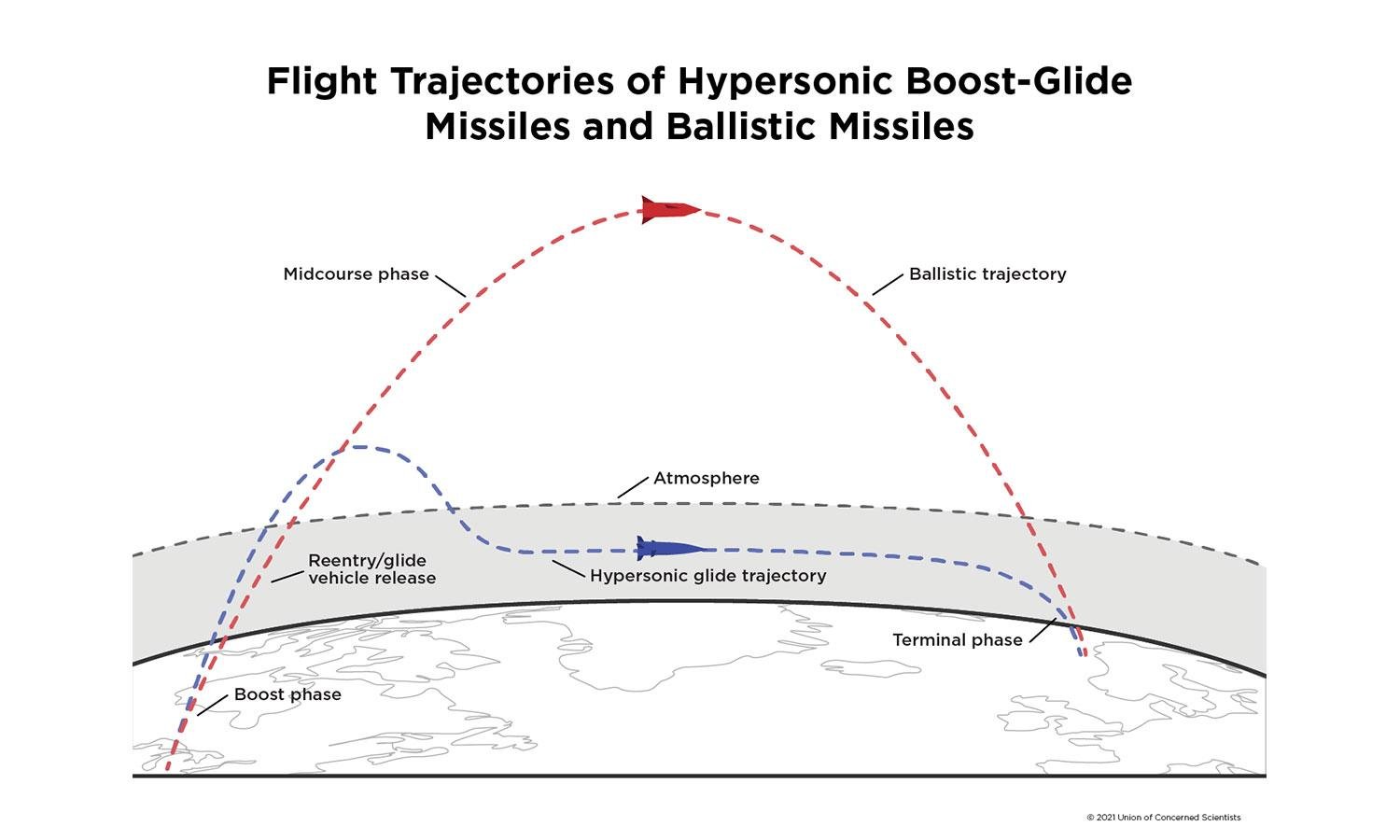
The Hypersonic Difference
Hypersonic weapons are named after a specific velocity regime—five times the speed of sound or greater. But this nomenclature is misleading, as these flight speeds are nothing new. Ballistic missiles—which represent the state of the art in rapid warhead delivery and are widely deployed by the United States and others—have flown at hypersonic speeds for more than half a century.
Hypersonic weapons are distinguished not by speed but by their flight trajectories. Ballistic missiles launch warheads on the fronts of booster rockets, which accelerate them through the atmosphere. Once these rockets run out of fuel, typically a few minutes after launch, they fall back to Earth. The warhead, carried in a conical reentry vehicle, continues on, following a predictable, arcing flight path high into outer space before falling back to its target on Earth’s surface (see Figure 1). If the missile is equipped with a maneuverable reentry vehicle (MaRV), a technology first developed in the 1960s, it can alter its flight path after reentering the atmosphere (this terminal phase typically constitutes the last few minutes of flight; Bunn 1984). This maneuvering allows ballistic missile reentry vehicles to enhance their accuracy or evade missile defenses.
The fastest hypersonic weapons, known as boost-glide missiles, begin flight in the same manner as ballistic missiles. Booster rockets accelerate them through the atmosphere and into outer space. But there, their flight paths diverge from those of ballistic missiles. Instead of continuing on a ballistic trajectory through outer space, hypersonic gliders dive back into the atmosphere and execute a pull-up maneuver to enter into a stable, near-horizontal glide. Taking advantage of aerodynamic forces, they generate lift sufficient for sustained flight over long distances through the atmosphere, allowing them to maneuver throughout this glide phase, if desired.
It is this difference in trajectory—flight at low altitudes through the dense atmosphere, rather than the vacuum of outer space—that distinguishes hypersonic weapons from ballistic missiles. To be sure, other classes of missile technology can achieve similar low-altitude flight trajectories. Cruise missiles, whether traveling at hypersonic or slower speeds, use onboard engines to stay aloft during continuously powered, atmospheric flight. But cruise missiles cannot match the high speeds of ballistic and boost-glide varieties, and they constitute only a small fraction of the hypersonic weapons currently under development. Therefore, this report focuses on the faster boost-glide and ballistic missile technologies.
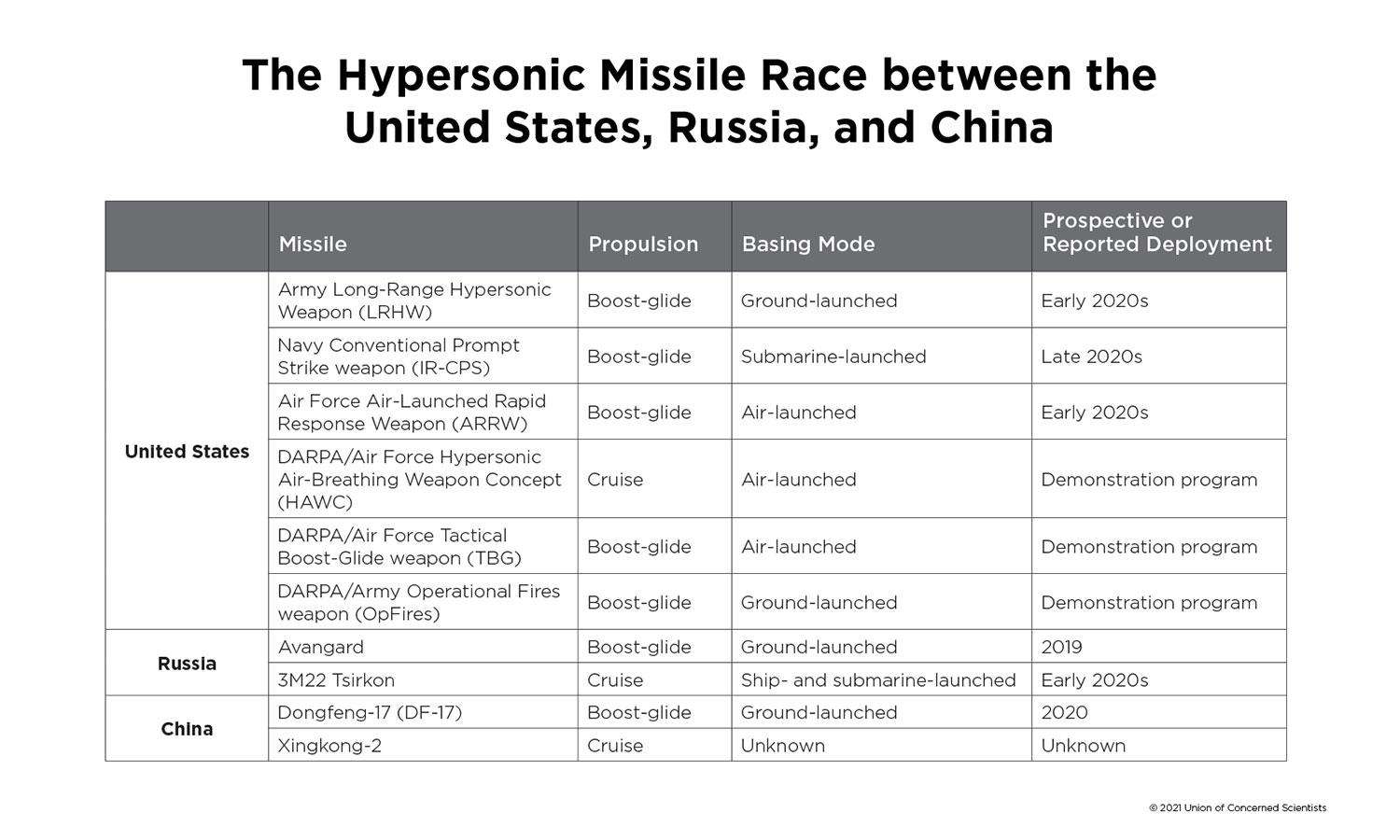
Hypersonic Weapon Development, Past and Present
While commonly billed as a novel technology, hypersonic weapon development dates back nearly a century. The hypersonic boost-glide weapon was first conceived of in the late 1930s by German engineers who sought a means of attacking the United States from Europe (Sӓnger and Bredt 1944). Yet Germany declined to pursue this technology, judging ballistic missiles to be a cheaper, more effective means of executing long-range strikes.
The United States became interested in these weapons in the subsequent decades, refining their designs and conducting a number of test flights throughout the 1960s. This testing was accompanied by massive investment in the technology, including $5.5 billion (in 2021 dollars) for the X-20 Dyna-Soar boost-glide vehicle. This development never came to fruition. The Department of Defense (DOD) abandoned the Dyna-Soar project when it could not identify any specific mission for the system (Geiger 1963). This general disinterest in the deployment of hypersonic weaponry persisted throughout the remainder of the 20th century.
With the turn of the century, the United States began to reconsider hypersonic missile technology. In the post-Cold War global security environment, the nation faced a new set of adversaries, including terrorist groups. This prompted an interest in the use of long-range missiles—previously used primarily with nuclear warheads—to deliver conventional explosives as part of the Conventional Prompt Global Strike (CPGS) program. Hypersonic boost-glide weapons were considered for this purpose not because of any particular performance advantage, but because their distinct trajectories would be easily distinguishable from those of nuclear-armed intercontinental ballistic missiles (ICBMs); other nations would be unlikely to mistake a hypersonic weapon strike for a nuclear attack (Woolf 2020). The United States, believing at the time that it would be the first to deploy hypersonic weapons, went so far as to specifically exclude them from New START (i.e., the Treaty between the United States of America and the Russian Federation on Measures for the Further Reduction and Limitation of Strategic Offensive Arms), an arms control treaty limiting the deployment of other long-range missiles (New START Hearings 2010, 193).
Despite this newfound enthusiasm for an old technology, US hypersonic weapon development progressed more slowly than anticipated. Testing of long-range gliders, such as the Hypersonic Technology Vehicle 2 (HTV-2), yielded mixed results (Acton 2015). At the same time, US defense interests evolved. Competition with major military powers such as Russia and China came to eclipse counterinsurgency missions. By the mid-2010s, the DOD’s focus had shifted from long-range hypersonic missiles to shorter-range systems meant for use in a particular theater of operations; the CPGS program was reconfigured as Conventional Prompt Strike (Woolf 2020, 5). Yet this shift in strategy was not accompanied by any clear rationale for the necessity of these weapons, as opposed to alternatives like ballistic missiles (Acton 2013). To date, no technical basis has been provided to show that this relatively short-range, theater-scale mission necessitates the costly development of a new missile technology.
By the 2010s, Russia and China had initiated large-scale hypersonic weapon development programs of their own. Russia’s intercontinental-range Avangard and China’s medium-range Dongfeng-17 boost-glide vehicles are reportedly operational, making them the first—and, to date, only—hypersonic weapons to enter into service (Panda 2019). These nations’ motivations for developing such weapons are distinct from those associated with US development programs. Russian and Chinese hypersonic programs are, in large part, responses to US pursuit of these weapons and US development of missile defenses. Chinese experts commonly argue that China’s development programs aim to “counter specific security threats from increasingly sophisticated US military technologies, including CPGS” (Zhao 2018, 16). Similarly, Russian President Vladimir Putin characterized his nation’s deployment of a nuclear-armed, intercontinental-range hypersonic missile as a direct response to US deployment of strategic missile defenses that might threaten Russia’s nuclear deterrent (President of Russia 2018).
In light of these developments, US defense officials have voiced concern that the United States might be falling behind in a budding hypersonic arms race, prompting the DOD to pursue large year-on-year increases in funding for development of hypersonic weapons and associated defenses (Davenport 2018). The United States currently funds work on at least five distinct hypersonic weapons spread across the US Army, US Navy, US Air Force, and Defense Advanced Research Projects Agency (DARPA). Three of these weapons (the US Army’s Long-Range Hypersonic Weapon, the US Navy’s Conventional Prompt Strike weapon, and the US Air Force’s Air-Launched Rapid Response Weapon) are scheduled for deployment in the 2020s (Sayler 2020).
The table summarizes known hypersonic weapons under development or deployed in the United States, China, and Russia (Sayler 2020). These weapons have diverse basing modes and include both boost-glide and cruise varieties (primarily the former). They also differ in range: Russia fields an intercontinental-range hypersonic missile, while most others are intended for use in a particular theater of operations, with ranges of a few thousand kilometers. Finally, they differ in the payloads they might carry. US weapons are currently intended for use with conventionally-armed warheads, while Russia’s Avangard is nuclear-armed. The type of warhead that might be carried by the other systems is unclear, and many are potentially dual-use weapons.
Motivations for the development of hypersonic weapons and plans for their use have continuously shifted over the long history of this technology Meanwhile, the technology itself and the capabilities it offers have remained relatively constant. Today, several nations are pursuing these weapons for entirely different reasons. Absent a clear technical basis for why these new weapons are needed, and why existing weapons cannot fulfill the same roles, important questions arise concerning just what is driving hypersonic weapon acquisition. Is it premised on rational assessment of military needs and determination of the technologies that best fulfill those needs, or on an arms race in which nations seek these weapons not because they are needed but because others are doing so?
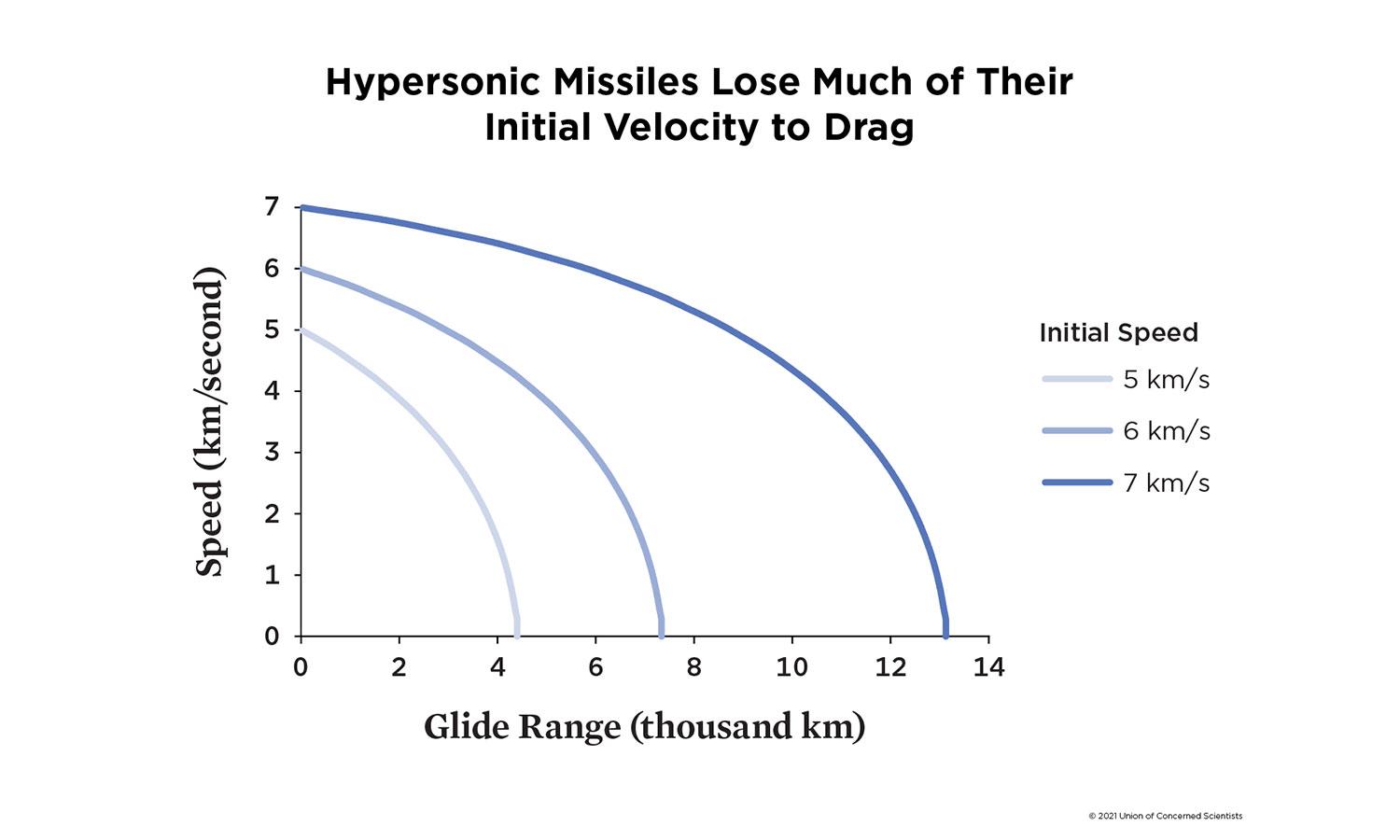
Hypersonic Boost-Glide Weapon Capabilities
Despite the aforementioned claims of revolutionary performance that underlie most calls for accelerated US hypersonic weapon development, the actual capabilities of these missiles remain controversial. In several recent critical assessments, experts have pointed out limitations on hypersonic missile performance, particularly relative to the performance of existing ballistic missile technologies (Oelrich 2020; Terry and Cone 2020). Many of these limitations are imposed by the fundamental physics of hypersonic flight, such that technological progress and increased funding are unlikely to overcome them. Yet large uncertainties in hypersonic weapon capabilities remain, due in part to a lack of open-source data. Defense officials claim that classified data show hypersonic weapons perform better than prior analyses suggest (Freedberg 2021).
To clarify the performance of these weapons relative to currently deployed missiles, the Union of Concerned Scientists developed a computational model of hypersonic missile flight. This model, described in detail in a recent report, enables the estimation of key performance parameters of modern boost-glide weapons, including the time necessary for flight to a given range, maneuverability, and infrared light emission (which governs detection by satellite sensors; Tracy and Wright 2020). These calculations are based on flight test data from the HTV-2, a long-range, wedge-shaped glider developed by DARPA and tested within the past decade. Wedge-shaped gliders typically have superior aerodynamics (e.g., higher lift-to-drag ratios) than the simpler conical systems on which the DOD has recently focused, so the results discussed here may overestimate glider performance (Larson 2020).
To determine whether hypersonic weapons represent a significant advancement over existing missile technologies, it is useful to compare hypersonic weapon performance with that of ballistic missiles, the current standard for swift warhead delivery. Here, we use modeling to compare these two classes of missile technology with respect to five key performance parameters: speed, maneuverability, accuracy, detectability, and evasion of missile defenses
Flight Speed and Warhead Delivery Time
Hypersonic weapons take longer to reach their targets than comparable ballistic missiles, for both intercontinental and theater-scale use.
Compared with the arcing flight paths of ballistic missiles, hypersonic weapons follow relatively short, direct paths to their targets (see Figure 1). But detrimental effects of atmospheric drag on flight speed balance this path length advantage. While ballistic missiles fly primarily through the vacuum of outer space, hypersonic glide takes place in the relatively dense atmosphere, where air resistance continuously slows the weapons’ flight.
For example, modeling of hypersonic glide shows that a vehicle initially gliding at 18 times the speed of sound (about six kilometers per second, near the upper end of what the fastest boost-glide weapons can achieve) would lose roughly half of this velocity after gliding for 6,000 kilometers (see Figure 2; Tracy and Wright 2020). This drag effect substantially increases the amount of time it takes a glider to reach its target. In contrast, ballistic missiles are subjected to drag for only brief periods at the start and end of their flight, thus maintaining their high velocity for most of their trajectories.
As a result of these drag effects, hypersonic missiles take longer to reach their targets than do ballistic missiles using the same rocket boosters and similar launch trajectories (see Figure 3). While the ballistic missile delivery time advantage narrows at shorter ranges, ballistic missiles remain faster than hypersonic weapons even for the relatively short ranges associated with theater-scale use. Indeed, the slower hypersonic vehicles that might be used for relatively short-range strikes are particularly susceptible to atmospheric drag, since they fly at relatively low altitudes. A vehicle starting glide at eight times the speed of sound (~2.4 km per second) would slow to below hypersonic speeds after gliding for a mere 500 km. In short, claims that hypersonic weapons can compress warhead delivery times—often touted by defense officials as a justification for rapid development of these systems—are false.
Maneuverability
Hypersonic weapons are more maneuverable than ballistic missiles, but their maneuvering comes at the cost of reduced speed and range.
While atmospheric forces subject hypersonic gliders to a speed penalty, they also allow these vehicles to maneuver for much of their flight time. Ballistic missiles equipped with MaRVs can do the same, but only in the terminal phase of flight—the final few minutes when they reenter the atmosphere from outer space (Bunn 1984).
Still, the maneuverability of hypersonic weapons is strictly limited by the physics of hypersonic glide, which necessitates a trade-off with glider velocity and range. To turn to either side, a glider must rotate such that a portion of the lift it generates during flight is reoriented to the horizontal direction. This means that less of this lift acts counter to gravity. Therefore, turning either pulls gliders to lower altitudes, where dense air yields even higher drag, or requires that they tilt up to generate additional lift, concomitantly generating additional drag (Oelrich 2020). In either case, maneuvering further slows glider flight and reduces the maximum achievable flight range (see Figure 4).
In short, hypersonic weapons can maneuver for a longer portion of their flight than can ballistic missiles. Still, even if a need for this increased maneuverability were identified, it remains limited and incurs steep penalties on other, already inferior, performance parameters, such as flight speed.
Accuracy
Hypersonic weapons possess no intrinsic accuracy advantage over advanced ballistic missiles.
The ability of a missile to strike close to its target is key to its military utility. This is particularly true of missiles armed with conventional explosives, as is planned for US hypersonic weapons. Conventionally armed warheads produce smaller explosive yields than those armed with nuclear explosives and must therefore strike quite near their targets for the resulting blast to be effective. Myriad parameters govern accuracy, including external factors such as atmospheric variation and winds, and factors intrinsic to a particular weapon, such as the ability of a vehicle to detect deviations from its ideal flight path and to adjust its course to correct for these (Bunn 1984).
Because hypersonic weapons spend a relatively long portion of their flight in the atmosphere, they will be subjected to atmospheric forces for a longer duration than will ballistic missiles, putting them at a disadvantage by necessitating more extensive course correction. They will also suffer damage to their surfaces from aerodynamic heating, degrading their ability to precisely control their flight trajectories. Finally, they possess no advantage in terms of guidance, as both hypersonic and ballistic missiles use similar guidance systems.
Hypersonic weapons do have the ability to maneuver—and thus course correct—for long portions of their flight, whereas ballistic missiles with MaRVs can do so only for the final minutes of flight. But this short period is more than sufficient to execute the corrective maneuvers typically needed. For example, testing of a modern Trident D5 submarine-launched ballistic missile equipped with a MaRV demonstrated the ability of this vehicle to steer to within a few meters of the location identified by its guidance system, a feat on par with the best accuracy a hypersonic weapon might achieve (NRC 2008, 121).
Detection, Early Warning, and Tracking
Hypersonic weapons can be detected by existing space-based sensors during launch and throughout most of glide. Over shorter ranges, such as those relevant for missile defense, they can be detected and tracked by ground-based radar.
Missile detection and tracking are typically accomplished by two means: ground-based radar systems and space-based infrared light sensors. The distance from which a ground-based radar system can detect a missile depends on that missile’s altitude; at sufficiently low altitudes and long distances, the horizon will block incoming vehicles from a radar’s line of sight. Because hypersonic weapons fly at relatively low altitudes, they will typically be visible only to radar systems within hundreds of kilometers (Acton 2013, 156–57). Ballistic missiles, on the other hand, typically rise above the horizon at distances of thousands of kilometers. Thus, when it comes to long-range use, radars are less effective against hypersonic weapons than they are against ballistic missiles. With respect to shorter-range theater use, this horizon effect matters less.
Regardless of their visibility to ground-based radar, hypersonic weapons are quite vulnerable to detection by space-based infrared sensors of the sort currently deployed by the United States and Russia, and currently under development by China (OSD 2020, 89; Podvig 2002; Richelson 2012). These sensors, mounted on satellites, watch for the infrared light given off by hot objects, such as the exhaust plumes of the rockets on which ballistic missiles are launched.
Unlike ballistic missile reentry vehicles, which stay relatively cool as they fly through outer space, hypersonic gliders reach temperatures of thousands of degrees Celsius as they fly through the atmosphere, consequently emitting intense infrared light. Calculations show that the infrared light emission from a typical hypersonic glider will be sufficiently intense for detection by existing space-based sensors for much of its flight through the atmosphere (Tracy and Wright 2020). Thus, detection of hypersonic weapons is unlikely to pose a meaningful problem for advanced military powers.
Evasion of Missile Defenses
Hypersonic weapons could bypass some missile defenses, but this is not a new capability, as ballistic missiles could do so as well.
The vulnerability of a missile to interception by defensive systems is a complex function of its speed, visibility to sensors, and flight trajectory. As discussed previously, hypersonic weapons possess no meaningful advantages over ballistic missiles regarding the first two factors. In several respects, they actually perform worse than existing missile technologies. As a result, hypersonic weapons offer little in the way of new capabilities for the evasion of missile defenses.
Consider first the most common type of defensive system, which seeks to shield potential targets by intercepting incoming missiles as they close in on that target in the terminal phase of flight. As discussed above, hypersonic gliders would first be detected by space-based sensors. Once a glider was close enough to a defended area for interception to be feasible, these space-based sensors could cue ground-based radars co-located with the defensive system, providing continuity of tracking (Acton 2013, 156–57).
Having been detected, a hypersonic glider might still bypass terminal phase defenses if it could outpace or outmaneuver interceptors. Yet, by this terminal phase of flight, the glider would have lost a substantial portion of its initial speed to atmospheric drag (see Figure 2). It would approach its target more slowly than would a ballistic missile fired on a comparable rocket (Tracy and Wright 2020). Because maneuvering relies on lift forces generated by the vehicle, which are proportional to its flight speed, a hypersonic glider would be at a disadvantage in this respect as well, relative to a faster ballistic missile MaRV. In short, hypersonic weapons offer no new capabilities against terminal phase defenses, and they might actually be more vulnerable to interception by these systems than are ballistic missile technologies.
The second type of defensive system seeks to defend a large area by intercepting missiles outside the atmosphere, prior to their reentry into the atmosphere. Unsurprisingly, these midcourse defenses—designed to intercept missiles flying ballistic trajectories—would be ineffective against hypersonic weapons, which fly primarily within the atmosphere. Still, the ability of hypersonic weapons to evade these defenses is not unique. Midcourse defenses are ineffective against advanced, high-speed ballistic missiles, particularly if countermeasures such as decoys are used (Sessler et al. 2000). US systems, for example, have fared poorly against existing ballistic missiles in testing, even under ideal conditions (Grego, Lewis, and Wright 2016).
Regardless of their efficacy (or lack thereof), midcourse defenses are not widely deployed by potential adversaries of the United States. It is the United States that has pursued these defenses most aggressively, fielding the Ground-Based Missile Defense and both ship- and ground-based Aegis systems. Thus, the ability of hypersonic weapons to bypass this type of defensive system might motivate the development of these missiles by potential adversaries, such as Russia or China (although they could likely bypass such defenses with ballistic missiles), but it would offer little strategic utility to the United States, since adversaries do not widely field these defensive systems.
In short, hypersonic weapons offer nothing new with respect to the evasion of missile defenses. Regarding the most common variety of terminal defenses, they face several disadvantages relative to ballistic missiles.
A Rational Approach to Hypersonic Weapon Development
Given the apparent misalignment between the justifications provided for hypersonic weapon development and the actual capabilities of these weapons (or lack thereof), the United States should carefully reconsider its investments in these technologies. To date, the DOD has not articulated a clear military role for hypersonic weapons, nor has it identified a mission that could not be carried out using existing ballistic missile technologies. In the past two decades alone, the DOD’s general rationale for hypersonic weapon development has shifted dramatically, from long-range use against nonstate actors to theater use against rival nations. Meanwhile, hypersonic technology and the potential capabilities of these missiles remain largely unchanged, indicating a disconnect between hypersonic technology and strategy. Indeed, one in-depth analysis aptly characterized these weapons as “a missile in search of a mission” (Acton 2013, 9–11).
While the utility of hypersonic weapons remains uncertain, the costs of their development are clear. First, the hypersonic arms race poses a serious global security risk. Adversaries will perceive any US buildup of these weapons as a potential threat and seek their own hypersonic weapons to avoid being left behind, further motivating rapid US development. These cyclical arms race dynamics could heighten international tensions, increasing the likelihood of conflict and diminishing prospects for cooperative arms control (Glaser 2000).
Second, pursuit of hypersonic weapons without a defined strategic role or a clear technical basis for their assessment risks wasteful, inefficient use of limited financial resources. The billions of dollars spent yearly on the multitude of hypersonic weapons currently under development in the United States cannot be used for other priorities that would enhance national security. The diversion of these funds to an overhyped, underperforming missile technology could therefore reduce the overall security of the United States. Meanwhile, ballistic missile and MaRV technologies might fulfill the same strategic roles as hypersonic weapons and could likely be refined and deployed at a lower cost, leaving funds available for other purposes.
With these costs in mind, the Biden administration should resist the temptation to rush into an arms race based on hyped-up claims about hypersonic weapon performance. Instead, it would do well to articulate the specific purpose each of the weapons currently under development is meant to serve, and to examine whether existing missile technologies might carry out that mission as effectively and more cheaply. Next, Congress should strictly exercise its oversight role to prevent overspending on an old technology. It should withhold funding from hypersonic missile programs that do not demonstrably contribute to national security by way of new capabilities necessary to fill an unfilled tactical or strategic role. It is unlikely that all of the ongoing US hypersonic weapons programs meet this standard.
This enhanced scrutiny and restricted funding need not limit US hypersonic know-how. Research-oriented hypersonic weapon programs, such as those carried out by DARPA, would be sufficient to ensure technological readiness, should a need for these weapons be identified in the future.
Similar assessment and congressional oversight should be applied to systems meant to defend against adversary hypersonic weapons, as their necessity also hinges on the performance of these missiles. Consider, for example, the vast satellite constellation the US Space Development Agency is currently designing for detection and tracking of hypersonic weapons (Erwin 2020). Calculations indicate that existing satellites might provide sufficient detection capabilities for early warning of hypersonic attacks and for cueing radar systems coupled to missile defenses (Tracy and Wright 2020). Enhanced scrutiny and rigorous assessment of the proposed system is therefore warranted to determine whether the development of these costly, potentially redundant new sensors is an effective use of resources.
To facilitate informed scrutiny of hypersonic weapons, policymakers need unbiased, accessible information and quantitative data on hypersonic weapon performance. Yet much of the debate around US hypersonic policy has been based on hype and unsubstantiated claims. An up-to-date technical assessment from an independent body, such as the National Academy of Sciences, would provide a reliable basis for assessment of the potential capabilities of these systems, and for decisions regarding their costs and benefits. Rigorous, evidence-based analysis of both technical and strategic aspects of US hypersonic policy is necessary to avert a technological arms race over weapons of questionable utility.
ACKNOWLEDGMENTS
This report was made possible through the generous support of the estate of the late Henry Kendall, the Kendall Science Fellowship program, and UCS members. For their thoughtful reviews and contributions, we thank David Wright (Massachusetts Institute of Technology) and several anonymous reviewers. At UCS, we thank Laura Grego, Stephen Young, Bryan Wadsworth, Cynthia DeRocco, and Kathy Rest for their help in developing and refining this report. We also thank Cynthia Williams for her editing work, and Tyler-Kemp Benedict for her design work. Organizational affiliations are listed for identification purposes only. The opinions expressed herein do not necessarily reflect those of the organizations that funded the work or the individuals who reviewed it. The Union of Concerned Scientists bears sole responsibility for the report’s contents.
This is a condensed, online version of the report. Access to all figures and full report are available through download of the PDF.
Downloads
Citation
Tracy, Cameron. 2021. "Slowing the Hypersonic Arms Race: a Rational Approach to an Emerging Missile Technology". Cambridge, MA: Union of Concerned Scientists. https://www.ucsusa.org/resources/slowing-hypersonic-arms-race
